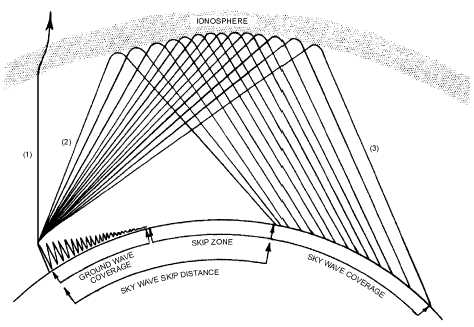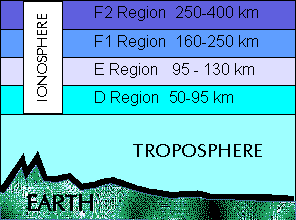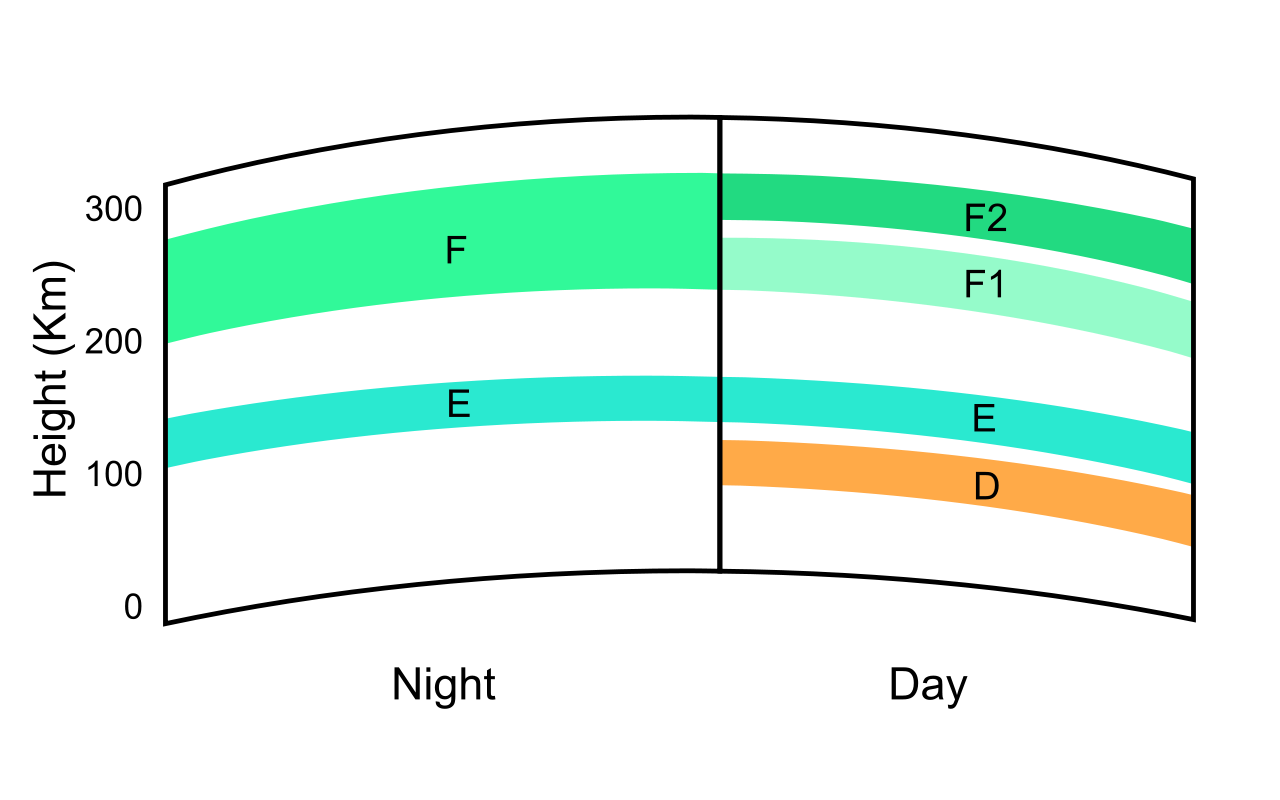8a. Propagation
Definitions
- Propagation is happens to the radio signal between it leaving the transmitter aerial and it arriving at the receiver aerial
- Refraction is the deflection of a ray of light etc when it passes obliquely from one medium (water, air, glass etc) to another
- Sun Spot appears as a dark patch on the sun and causes increased ionisation around our world
- Skip distance is the distance between the transmitter and the nearest point on earth where the signal is receivable after having been refracted back from the ionosphere
- Fading causes large changes in the strength of a signal at the receiver aerial due to the signal arriving via 2 or more paths
- Automatic gain control (AGC) is a closed-loop feedback regulating circuit, the purpose of which is to provide a controlled signal amplitude at its output, despite variation of the amplitude in the input signal
- Selective fading will occur when the refractive effect of the ionosphere varies with frequency
- Critical Frequency is the highest frequency signal that, when transmitted straight up, will be reflected (total refraction) back to earth at the same point
- Maximum Usable Frequency (MUF) is maximum frequency that can be used to communicate between two stated places. MUF includes path and time of the day.
- Temperature inversion happens in the atmosphere when warm air rises (due to smoke) and cold air is above ground
Diagrams
-
Skip distance, skip zone

Image credit: Electrician training
-
Ionosphere height

Image credit: image
-
Ionosphere day and night

Image credit: Wikipedia
Notes
Ground wave
- simple case of the signal traveling across the ground (or sea) to the receiving aerial
- actual distance possible will depend on the conductivity of the terrain
- example:
- best: over salty water
- worse: over sandy desert
- distance:
2MHztravels100s km21MHztravels10km - 1km
Low frequencies are so good for world wide communication. Why are they not used more often?
- The frequency is too low to carry the bandwidth of speech modulation
- Being low, there are not many frequencies available
Ionosphere
Radio waves are refracted by the ionosphere
- The well known long distance (DX) Amateur Bands
14MHz, 16MHz, 21MHz, 24MHz, 29MHz - Variables:
- strength of the suns rays
- day / summer –> higher ionisation
- night / winter –> lower ionisation
- height, thickness and density of the ionosphere
- position and density of the ionosphere dictate which frequencies will be refracted and by how much
- Sun Spot activity varies over the years - peaking and dipping (troughing) every 11 years
- strength of the suns rays
| ionosphere layer | Position | Description |
|---|---|---|
| D | 60km - 85km |
- Absorbs rather than refracts radio waves - Absorption is inversely proportional to the frequency |
| E | 100km - 120 km |
- Lowest ionised layer that can usefully be used for ionospheric propagation - Refract (bend) radio waves during daylight hours, virtually disappears at night - Does not normally result in vast distances of communication (100s of miles, not 1000s of miles) |
| F | 140km - 400km 150-200 kms (F1) disappears at night |
- Height varies from vary rare to non-existent - Ionises very quickly at sunrise to reach a maximum just after midday - decay is so slow that the ionised layer remains present all through the darkness hours - F2 layer is most important |
Sky waves
- sky waves can be single or multi-hop
- In multi-hop propagation, the radio wave is refracted back to earth where It is reflected up again
- This is the way to communicate over the longest distances; to the opposite side of the world
Skip distances
- actual skip distance depends on:
- the time of day
- season
- frequency
| Frequency | Noon skip (km) | Midnight skip (km) |
|---|---|---|
1.9 MHz |
0 | 0 |
3.6 MHz |
0 | 0 |
7.1 MHz |
0 | 500 |
10.1 MHz |
350 | 1000 |
14.1 MHz |
600 | 1600 |
16.1 MHz |
1200 | Not possible |
21.1 MHz |
1300 | Not possible |
24.9 MHz |
1600 | Not possible |
26.5 MHz |
2000 | Not possible |
Fading
- Both single and double hop sky waves are received but the path lengths are very different
- two (or more) signals are most likely to arrive out of phase
- At one moment the signals will add and a little later they will tend to cancel each other out
- A receiver with good “automatic gain control” (AGC) can greatly overcome the problems of fading
- Selective Fading
- severe modulation distortion will take place
- speech may become unreadable
Fade out
- A major flare eruption on the sun will rapidly increase the ionisation of the E layer
- Its absorption will dramatically increase for a period of up to two hours
- Many radio signals will suddenly disappear during this time
Other types of Propagation
1. VHF Propagation (above 30MHz)
- Don’t get refracted by the ionosphere those going up, go on and on to get lost in space
- Signals tend to travel more or less in straight lines
- VHF aerials are usually designed to transmit the VHF signal in a narrow beam, parallel with the earth’s surface
- terrain becomes very important
- Tip: If you intend to operate on the VHF/UHF Amateur Bands you should try to live on top of a hill
- Obstacles can be an advantage as a reflection to the possible destination
2. Tropospheric ducting
- Sometimes there might be a layer of warm air in the atmosphere above the cool air on ground
- temperature inversion
- smoke rises
- Temperature inversion will conduct VHF signals over long distance
3. Aurora / Northern lights
- ionised waving curtain also reflects VHF radio signals
- The Northern Lights result from large solar flares on the Sun
- Disadvantage causes large Doppler frequency shift
- Tip makes Morse necessary rather than ghostly speech
4. Meteor tail
- When meteors pass through the earths atmosphere they create short term ionised tails behind them
- It may last only for a few seconds but contacts over 2000KMs are possible
- Disadvantage Lasting only a few seconds
- Tip Speeded up Morse is usually sent and a tape recorder used at the receiving end to slow it down again
5. Moon bounce
- requires high gain aerials
- high power sensitive receivers
- Disadvantage Moon is not an easy target to hit with a radio wave as it keeps moving
6. Amateur satellites
- amateurs using satellites must follow them across the skies with their aerials
- Disadvantage They are constantly on the move relative to the earth in non geostationary orbits
- Unlike the “passive” moon an Amateur Satellite re-transmits the received signal on another Amateur Band